

| Uxmal was one of the first large Puuc towns, which assumed dominance in the region. A long sacbé links it to Kabah. Its name means thrice built but it's unclear how often it was in fact rebuilt. The most striking and beautiful buildings--the so-called Nunnery and the Governor's Palace--were built during the reign of Lord Chac (Chan-Chak-Kaknal-Ahaw) in about 890-910 CE. This site includes the following: Pyramid of the Magician--page 1 below (12 images) Quadrangle of the Birds--page 2 (10 images) The Nunnery, East and West Buildings--page 3 (9 images) The Nunnery, North and South Buildings--page 4 (10 images) The Ball court, House of the Turtles, Great Pyramid, and smaller buildings--page 5 (14 images) Governor's Palace--page 6 (12 images) sculptural works from the Uxmal Museum--page 2 (2 images) Left: East side of the Pyramid of the Magician (also called the Pyramid/House of the Dwarf);center: east side from the south; right: top--east sideAbout 125 feet above ground level, the shape of this pyramid is unusual; it is an oval with rounded ends on the north and south. This reconstruction is controversial. The back side is probably this east side, even though it has a ramp of steep stairs. The temples at the top face west, however. Archaeologists believe the building was constructed in five stages and identify five different temples, with the very top, Temple V, built in about 900 CE. | ||
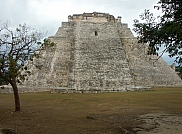
|
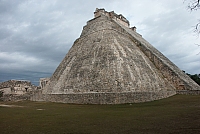
|
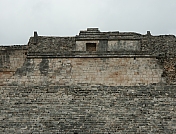
|
Center: west side from the north; right: west sideAn earlier staircase was found beneath this one on the west side. Archaeologists discovered the misnamed Queen of Uxmal there--actually a man looking out a snake's mouth. |
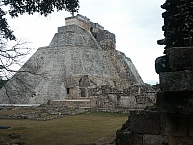
|
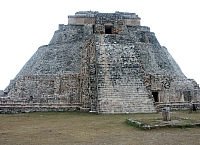
|
Pyramid of the Magician--details west sideThere are 150 steps which are flanked by masks depicting the rain god. | ||

|
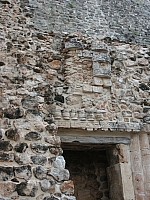
|
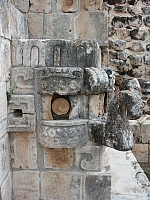
|
Temple IV (next to highest) and Temple V (the highest stage)Temple IV has a large Chenes style rain god mask, the mouth of which is the entrance to the temple. (See also Chicanná.) Temple V has Puuc style lattice work panels. Andrew Coe defines these as stone mosaics in the form of crosshatched matting, saying " Mats were associated with power; Maya lords often referred to themselves as the 'Lords of the Mat'"(357). | ||
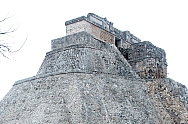
|
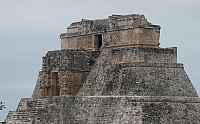
|
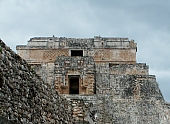
|
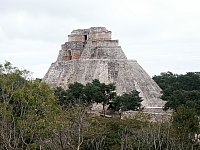
|
View from the southwest (from the platform of the Palace of the Governor) |
|
 Go to the Mexico Index.
Go to the Mexico Index. Click here to return to index of art historical sites.
Click here to return to index of art historical sites.
 Click here to return to index of artists and architects.
Click here to return to index of artists and architects.
 Click here to return to chronological index.
Click here to return to chronological index.
 Click here to see the home page of Bluffton College.
Click here to see the home page of Bluffton College.
